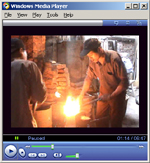
|
|
Most people have an idea of how a katana is made traditionally in Japan. However, few has an understanding of how a production sword is made. The making of a quality production katana is still a labor intensive process. This is not an automated deal with a big machine stamping out blades as some would think. The production of swords are only made more efficient here with use of shared labor production... When you consider how much work, sweat, and muscles that goes into each individual blade at the end of the day, you will realize what a bargain these swords are. (PHOTOS UPDATED - You can now click on them to see a larger image.) The process, simplified, is to transform the billet (image to the left), through the various stages as pictured (image to the right), then finally into a finished blade (on far right)... (sorry about the newspaper... but I didn't want to get the finished blade dirty).
The process starts with heating the billet of a specific metal, then forging to the approximate shape of the blade, followed by a water or oil quench (picture on far right -- quenching in the yellow barrel). Carbon monosteel billets are generally not folded as carbon distribution are already consistent throughout to began with, plus the level of impurities is extremely low in modern steel. (Historically, the main purpose of folding is to add and distribute the carbon contents evenly and to remove impurities in the steel.. which is generally of poor quality when compared to modern steel). Extended heat forging/folding will also oxidize the carbon content and promote carbon loss so the process needs to be monitored carefully. This is, perhaps, the most critical step in determining the quality of the blade material and is managed through the experience of the swordsmith.
The shapers then adjusts the blade and remove excess material by hand. The details on various areas starts to take shape and the blade is tempered again to relieve the stress in the metal followed by another quench. On our hand clayed and tempered blades, clay is applied by hand on the blade at this stage, immediately before the second temper to critical temp.
At this point, the polishers add their final touch on the blade... This is also where the traits of the individual polisher shows through in the final product. As each sword is hand finished by one person, batches from one polisher will have different traits from batches of a different polisher. Additionally, no two blades will be exactly identical even from the same polisher. Here, you can see our "assembly line" of 4 polishers working side by side. (This is our most time consuming process with a time ratio of 4:1 relative to the forging). (This is also the main reason why our different blades are priced differently... the harder (higher the carbon content in through hardened blades), the more difficult it is to polish, and will takes much longer to do -- it is why the 1060 mono costs more than 1045 or laminated steel).
In addition to the blade, the tsuka is also completely hand made. The image on the far left are the same skin (ray/shark skin) sheets. These are cut into panel wraps to fit the shape of the ho (wood handle). Fittings (either produced by our forge or purchased elsewhere) are prepared. Our "tsuka girl" then assembles the components and ties each individual tsuka-ito by hand to come up with the finished item on the far right.
The final assembler then takes over and puts together the blade with an appropriate tsuka, habaki, seppas, tsubas, and mekugi with some fine tuning adjustments. Several sayas are then tested with the blade for fit and one with the best fit is selected.
And there you have it.... the final product! I have simplified the process by alot, but you can get an idea of how much of the production swords are hand made and how much machinery are involved. As you can see, human labor involvement is tremendous and it will only be a matter of time before labor costs in China starts to climb and prices of these productions will be driven far beyond what they are now. Take a minute and consider what prices these production blades are selling at... the retail price would probably not cover even a fraction of the production labor if they were made in the US or other similar countries. Even as they are from China, you can see that we are providing a great bargain at the cost of our own profit margins. |
||||








